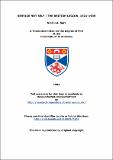Files in this item
Service not self : the British Legion, 1921-1939
Item metadata
| dc.contributor.advisor | De Groot, Gerard J. | |
| dc.contributor.author | Barr, Niall J.A. | |
| dc.coverage.spatial | 277 p. | en_US |
| dc.date.accessioned | 2015-08-03T10:39:13Z | |
| dc.date.available | 2015-08-03T10:39:13Z | |
| dc.date.issued | 1994 | |
| dc.identifier | uk.bl.ethos.601500 | |
| dc.identifier.uri | https://hdl.handle.net/10023/7101 | |
| dc.description.abstract | The organisation of ex-service men into a mass membership movement was a new departure in British life. Four main groups came together in 1921 to form the British Legion. On its establishment, the leadership, who were predominantly high- ranking ex-officers, had high hopes of forming an extremely powerful and influential organisation. Due to a number of inherent flaws in the Legion's ideology, composition and character, the organisation never became a truly mass movement of all ex-service men. This work looks at the dynamics of the movement and provides insights into the motivations of its leaders and their impact upon the organisation. It provides a detailed account of the structure of the Legion and explores the strengths and weaknesses of the movement. The existence of a semi-autonomous Officer's Benevolent Department, a subordinate Women's Section, and an independent Legion in Scotland reveal the serious rifts within this superficially unified movement. The paradox of low officer involvement combined with an almost exclusively officer leadership contributed to low membership and other factors such as geography, unemployment and finance are considered in the discussion of Legion membership. Divisions between leaders and led on policy and methods are explored in an examination of Legion democracy. A full examination of the Legion's practical work and the attitudes which underpinned that activity confirms the Legion's position as a voluntary society with traditional charitable views. A detailed examination of the Legion's struggles over pension legislation gives an insight into Government attitudes towards ex-service men and also reveals the inherent weakness of the Legion's position when dealing with politicians. An analysis of the Legion's contacts with foreign ex-service men penetrates the Legion's rhetoric and reveals the real motivations and attitudes of the Legion leaders who developed and executed the Legion's foreign policy. Ultimately, this study provides important conclusions about the nature of the British ex-service movement. | en_US |
| dc.language.iso | en | en_US |
| dc.publisher | University of St Andrews | |
| dc.subject.lcc | DA578.B2 | |
| dc.subject.lcsh | British Legion. | en_US |
| dc.title | Service not self : the British Legion, 1921-1939 | en_US |
| dc.type | Thesis | en_US |
| dc.type.qualificationlevel | Doctoral | en_US |
| dc.type.qualificationname | PhD Doctor of Philosophy | en_US |
| dc.publisher.institution | The University of St Andrews | en_US |
This item appears in the following Collection(s)
Items in the St Andrews Research Repository are protected by copyright, with all rights reserved, unless otherwise indicated.

